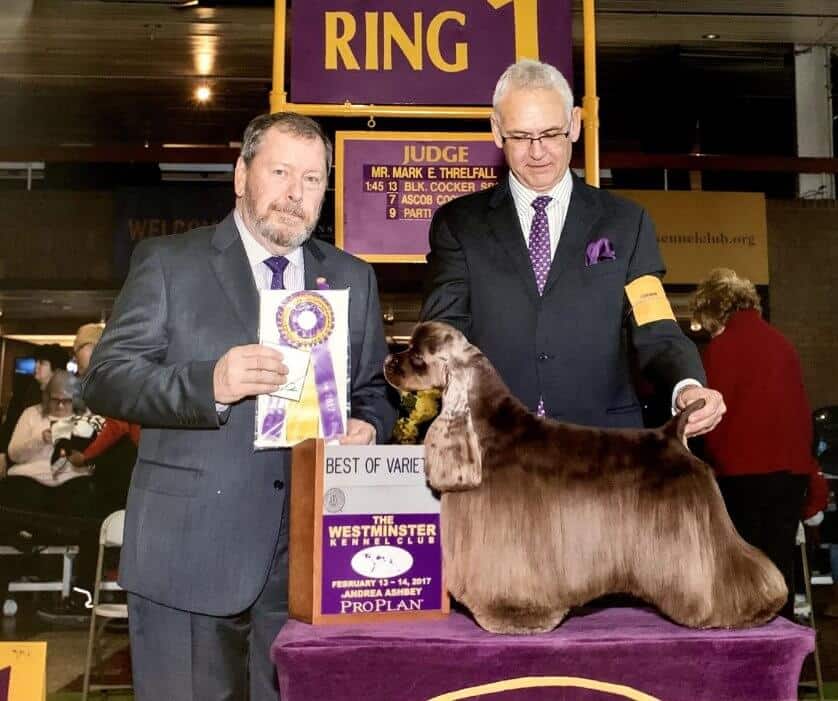Interview with Sporting Group Judge Mark Threlfall.
1. Where do you live? How many years in dogs? How many years as a judge?
2. What is your original breed? What is/was your kennel name?
3. Can you list a few of the notable dogs you’ve bred? Any performance or field titles?
4. How important are Performance and Companion titles in a Sporting Dog?
5. Have you judged any Sporting Breed Specialties?
6. Do you find that size, proportion, and substance are correct in most Sporting breeds?
7. Is breed-specific expression important to you as a judge? Can you offer some examples?
8. What are your thoughts on the current grooming practices among the coated breeds?
9. Are the Sporting breeds in good shape overall? Any concerns?
10. In your opinion, how do today’s exhibits compare with the Sporting Dogs of the past?
11. Why do you think the Sporting breeds make up a large portion of the typical show’s entries?
12. Just for laughs, do you have a funny story you can share about judging the Sporting Group?
Sporting Group Judge Mark Threlfall
I became involved in purebred dogs in 1969 as a teenager. I worked “from the bottom up” in a Poodle and Dachshund kennel in New Hampshire, the Harmo Kennels of Mrs. Anna H. (Mosher) Boardman. I worked there for three years, learning all facets of the practical end of breeding dogs. In Mrs. Mosher, I met one of the most principled breeders I have ever known. Her ethics and forthright manner were above reproach.
From Harmo, I went to work for Mr. William Trainor of Oxford, Massachusetts. Bill was the handler for Harmo Kennels, and from that introduction I became Bill’s assistant. For four years, I learned every aspect of the handling profession from one of the greatest gentlemen I have ever known.
From Bill, I went to work for Bob and Jane Forsyth in Southbury, Connecticut. For five years, I managed the show operation and oversaw the care and conditioning of the dogs, both on the show circuit and at home. The experience was invaluable, due in no small part to the exposure to many different breeds and to the breeders who owned them. Mr. and Mrs. James A. Farrell, Daniel and Phyllis Hamilburg, among others, taught me about the breeds they loved, and I learned of the special relationship between a breeder and their handler.
As a handler, in partnership with my ex-wife, I finished close to 500 dogs of all breeds and handled dogs from all seven variety Groups to all-breed Bests in Show. I was a member of the Professional Handlers’ Association from 1975 to 1995, and I’m proud of the fact that I was the youngest Board Member ever elected to that position. I served as its President from 1989 to my retirement from professional handling in 1995. I was part of the inaugural Board of the Certified Professional Handler organization. I am proud to say that I held Professional Handler Certification Board certificate number 0003 as one of the founding members.
Upon my retirement from showing dogs, I was hired by the American Kennel Club as Director of Special Services, a group set up to address the needs of the most-involved members of the fancy.
In 1999, I was hired as Director of Conformation Events for the United Kennel Club in Kalamazoo, Michigan. I was responsible for all event-related functions, including Event Operations, Judges Approval, and Judges Education. For the next 10 years, I enjoyed direct involvement in the Conformation Events, attending National Specialties, developing educational programs for many breeds, and even superintending a large annual event.
In 2002, while at the United Kennel Club, I applied to judge half of the Sporting breeds and was approved on a provisional basis. I was granted full approval for those breeds in 2004. In 2005, I applied for the remainder of the Sporting breeds. Shortly thereafter, the American Kennel Club adopted a policy making anyone with a significant interest in a competing registry ineligible to judge at AKC events. My Judges Approval was placed on hold until after I left the UKC in 2009. I was reinstated as an AKC Judge after that. I was granted regular status for the remainder of the Group in 2011.
I feel that I have been very fortunate in the sport. I met good people early on who shared their knowledge with me. I worked for some exemplary breeders, and it was rewarding to see a product from a breeding we had planned become a champion and a Group, Specialty or Best in Show winner. I truly appreciated my clients’ faith in me when they would ask for my advice about breeding, and that they would entrust me with their dogs. I did my best to justify that trust. I say that I am fortunate to have found a profession that I love and to have made friendships that have lasted a lifetime.
Where do I live? How many years in dogs? How many years as a judge? I live in New Hampshire. After a lifetime of living in other states and missing graduations, weddings, births, and other family events, I thought it was time to return to my roots.
I first got involved in purebred dogs in 1969. I first started judging in 2002. I had to take a few years off from judging because of a conflict with my job. I was reinstated as a judge in 2009.
What is my original breed? What is/was my kennel name? My original breed was English Springer Spaniels. I “married into” English Cocker Spaniels with my first wife, Bonnie. Our kennel name was Edgewood Farm.
Can I list a few of the notable dogs I’ve bred? Any performance or field titles? Bonnie has all of the breeding records. I would be remiss in trying to list them.
How important are Performance and Companion titles in a Sporting Dog? Titles are important insofar as they can give you a reference point in planning a breeding, but titles don’t ensure quality will be produced. Breeding dogs isn’t that simple. One plus one doesn’t always equal two. That is where pedigrees and a breeder’s instinct come into play.
Have I judged any Sporting Breed Specialties? Yes, quite a few. I enjoy them immensely. At a Specialty there is usually greater depth of the type of dog one is looking for.
Do I find that size, proportion, and substance are correct in most Sporting breeds? Generally, yes. In those breeds with height disqualifications, height plays a more prominent role. In those breeds without height disqualifications, one must apply common sense when deciding whether a dog’s size would hinder its ability to perform its intended function.
Is breed-specific expression important to me as a judge? Can I offer some examples? Yes. It has been said that “the eyes are the window to the soul.” Most Sporting Dogs have a soft, trusting expression which bespeaks their trust and willingness to perform any task set before it. English Cockers have a soft expression that foretells their merry disposition. Golden Retrievers have a soft expression, yet one that speaks to alertness and willingness to get the job done.
What are my thoughts on the current grooming practices among the coated breeds? This is an age-old point of contention. Those exhibitors who can trim well do so and will always suffer criticism when they win over those dogs whose owners are looking for a reason why their dog lost. The truth is, trimming can’t make a poor dog into a good one. Trimming should enhance a dog’s quality. No one was born knowing how to trim. Watch and learn from those who can present their dogs well. It’ll be time well spent.
Are the Sporting breeds in good shape overall? Any concerns? I think that there are some lovely examples of every breed being shown today. A lot of people will say, “Dogs were better in the old days,” but time is kind to old dogs. A dog that was a standout thirty years ago might not be the sparkling example today. But I’m not saying that dogs have gotten better. I think, years ago, we benefited from having fewer shows, shows where dogs from either coast or in the central US were forced to go if they wanted to attend a show. An example: In the middle of December, 50 years ago, if you wanted to go to a dog show and you lived east of the Mississippi River, there were shows in Boston—and that was it. So, every good dog showed up in Boston or they stayed home. This gave judges and exhibitors the opportunity to see the best dogs in the ring together, competing against each other. Crowds around the ring were deep. People learned from this type of head-to-head competition. Today, in smaller entries, it’s easier for a dog of lesser quality to amass wins because the competition went somewhere else.
In my opinion, how do today’s exhibits compare with the Sporting Dogs of the past? That’s really a tough question. I think that we had some great dogs in the past, but we’ve got some great dogs being shown out there today. What we didn’t have back then was the Internet, which gives everyone who has been in the breed for 10 minutes a forum to vent their uneducated opinion. In this sport, the cream rises to the top. It does today and it will tomorrow. There may be a couple of curds in there, but we’ll survive.
Why do I think the Sporting breeds make up a large portion of the typical show’s entries? They’re generally good companions, easy to train, and many require only a minimum of grooming. What more could you ask for?
Just for laughs, do I have a funny story I can share about judging the Sporting Group? A few years back, I was judging at an all-breed show. I had a young lady, who was obviously at her first show, come into my ring in a class of one. I asked her to take her dog around the ring. She did so. She set the dog up and I examined it. I then asked her to move her dog straight down to the corner and then back to me. She did that. I then asked the young lady to take her dog in a small circle and back to me. She took two steps away from me and proceeded to do a pirouette. I asked her to make a somewhat bigger circle, which she then did, red-faced, and I gave her the ribbon.









